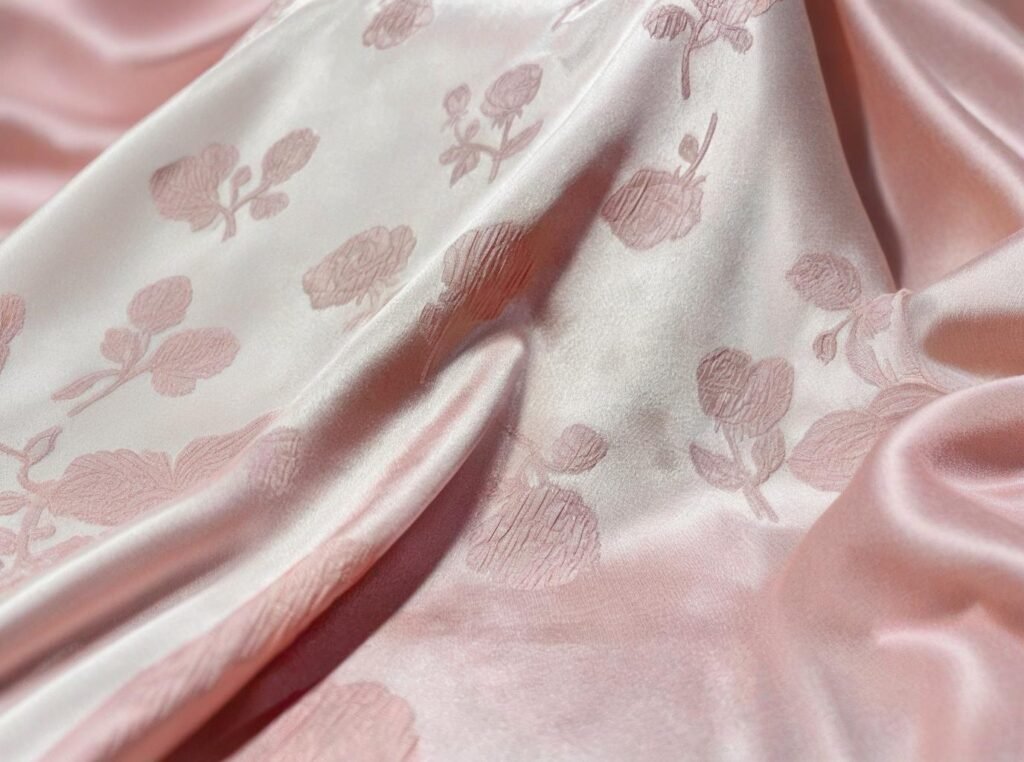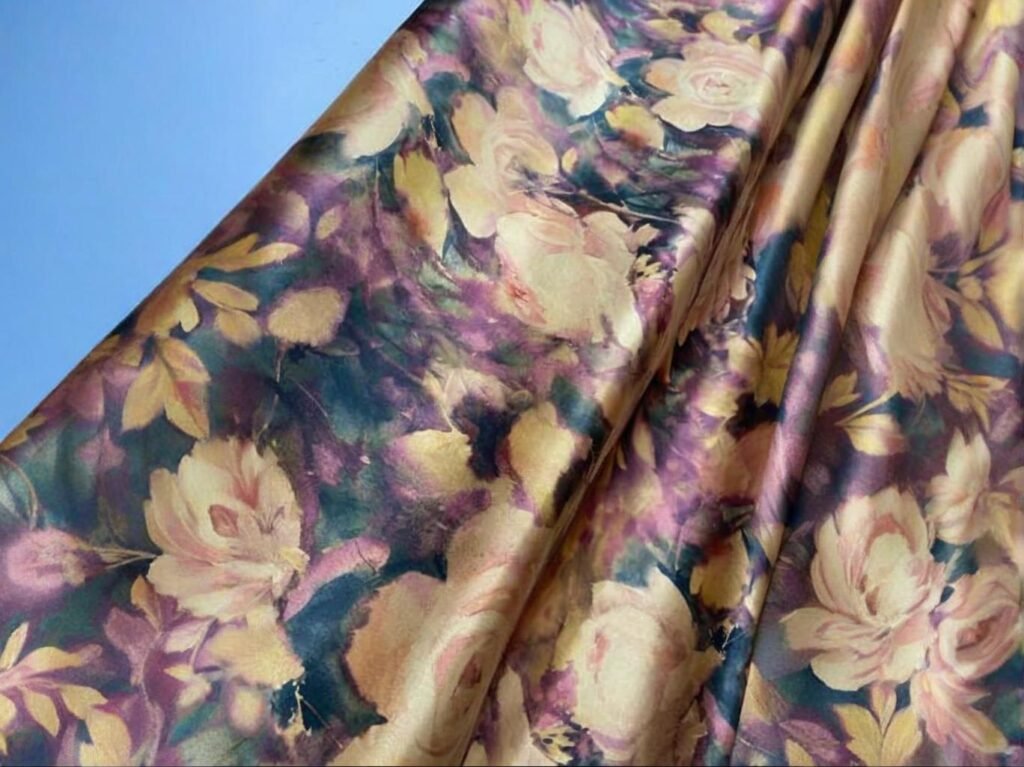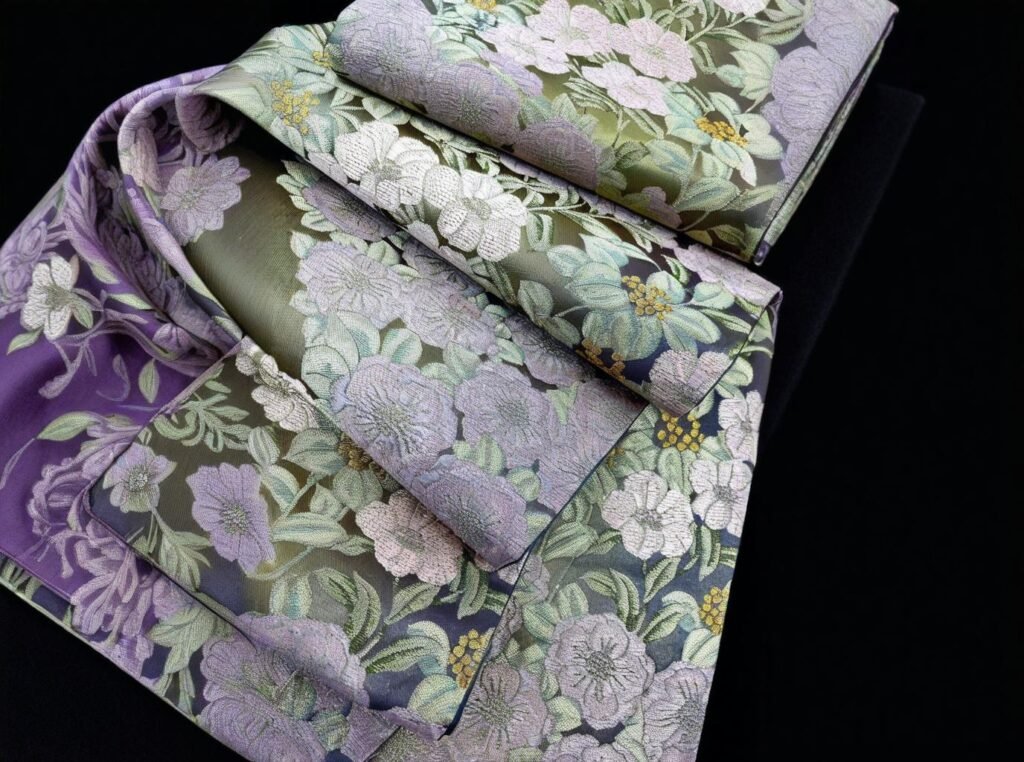Silk has captivated designers and consumers for centuries—but not all silk is created equal. Today, with growing awareness of sustainable sourcing and production speed, brands are asking deeper questions: Should I choose raw silk or processed silk? Which aligns with my values, timelines, and cost goals? Raw silk is less refined, more textured, and often more affordable than processed silk. While processed silk offers a smoother finish and higher sheen, it typically involves longer lead times, higher cost, and more chemical processing—raising sustainability concerns.
Understanding the trade-offs between raw and processed silk isn’t just a technical decision—it affects storytelling, sustainability positioning, and supply chain planning. In this article, we’ll unpack the structural differences, price points, production cycles, and environmental impact of both silk types to help you make confident fabric decisions. Let’s begin by clarifying what exactly separates raw silk from processed silk.
What Is the Difference Between Raw Silk and Processed Silk?

Raw silk refers to silk that retains its natural sericin coating—an organic, gummy substance that surrounds the silk fibers during reeling. It gives the fabric a slightly coarse texture, matte appearance, and more irregular surface. Processed silk, by contrast, has been degummed and subjected to additional refining, finishing, or calendaring treatments to yield a smoother, glossier, and softer fabric. Raw silk contains sericin and appears more matte and textured, while processed silk is degummed and treated for smoothness, sheen, and uniform drape.
While both are made from the same silkworm filaments, their handling diverges early in the production process—leading to very different tactile, visual, and performance characteristics.
Structural Differences Between Raw and Processed Silk
Comparison Table: Raw Silk vs Processed Silk
| Property | Raw Silk | Processed Silk |
|---|---|---|
| Sericin Content | Retained (10–30%) | Removed (degummed) |
| Surface Appearance | Matte, slubby, textured | Glossy, smooth, refined |
| Hand Feel | Dry, crisp | Soft, flowing |
| Drape | Stiffer | Fluid |
| Color Absorption | Slightly uneven | Uniform and deep |
| Usage Applications | Jackets, home decor, eco fashion | Lingerie, bridalwear, scarves |
| Environmental Processing | Minimal | Medium to high (depends on finishes) |
Cultural & Fashion Context
- Raw silk (e.g., Tussar or Matka) is valued in artisan crafts and eco-fashion.
- Processed silk (e.g., Charmeuse, Crepe de Chine) dominates luxury fashion and accessories.
Case Example
A zero-waste fashion brand in California uses raw silk in its unbleached, natural state to create earthy, high-touch garments. Their product descriptions embrace imperfections as part of the story—“handwoven elegance with a conscience.” Meanwhile, a heritage bridal atelier in Milan swears by processed 22 momme silk charmeuse for its flawless drape and light-catching luster.
How Does the Cost of Raw Silk Compare to Processed Silk?
Raw silk is generally less expensive per meter than processed silk because it requires fewer production steps. By skipping degumming, bleaching, and intensive finishing, raw silk saves on energy, chemical usage, and labor. However, price varies by yarn type, weave complexity, and origin. Raw silk typically costs 15–30% less than processed silk due to minimal finishing steps, making it a budget-friendly choice for natural or rustic-style products.
While silk pricing fluctuates based on international cocoon supply, finishing stages often contribute significantly to cost increases.
Cost Structure Breakdown
Average Fabric Cost Comparison (Global Estimates, USD/meters)
| Silk Type | Base Price Range | Degumming Included | Finishing Steps | Final Cost (USD/m) |
|---|---|---|---|---|
| Raw Silk (Plain Weave) | \$12 – \$18 | No | None or minimal | \$12 – \$18 |
| Processed Silk (Crepe) | \$18 – \$28 | Yes | Multiple | \$22 – \$35 |
| Silk Charmeuse (22 Momme) | \$26 – \$38 | Yes | Polished, softener | \$30 – \$42 |
Other Cost Factors
- Momme Weight: Heavier silk (22–25 momme) incurs higher raw material and weaving costs.
- Custom Color Matching: More difficult with raw silk due to uneven surface, increasing dyeing trial costs.
- Import Tariffs & Certifications: Some processed silk imports face higher duty rates due to chemical finishes.
Case Study
A menswear tailoring house in Tokyo shifted from 100% processed silk lining to raw silk for eco-conscious seasonal jackets. Not only did they save \$7 per meter, but their marketing around “imperfect beauty” helped justify retail prices without lowering profit margins.
Which Type of Silk Has a Faster Production and Delivery Lead Time?

Raw silk generally has a shorter production lead time than processed silk because it skips multiple refining stages, including degumming, bleaching, calendaring, and softening. This streamlined process allows raw silk to move from reeling to weaving and into inventory or sampling faster—especially when ordered in its natural color. Raw silk has shorter lead times than processed silk, often by 7–14 days, since it bypasses chemical treatments and labor-intensive finishing stages.
For brands racing against fashion calendars or seasonal drops, this time advantage can be critical. However, the lead time gap narrows if processed silk is in stock or if raw silk is ordered in custom shades.
Lead Time Comparison and Production Timelines
Lead Time Breakdown by Silk Type (Estimated)
| Stage | Raw Silk | Processed Silk |
|---|---|---|
| Reeling & Yarn Preparation | 3–5 days | 3–5 days |
| Weaving | 5–7 days | 5–7 days |
| Degumming | — | 3–5 days |
| Dyeing (Plain Color) | 3–5 days | 5–8 days |
| Finishing (e.g., softening, calendaring) | — | 3–5 days |
| Total (custom dyed) | \~12–15 days | \~20–30 days |
| Total (undyed/off-white) | \~7–10 days | \~15–20 days |
Variables That Impact Timeline
- Color Customization: Raw silk can be dyed, but the sericin makes uniform coloration more difficult, often requiring additional test runs.
- Post-Dye Finishing: Processed silk often undergoes anti-wrinkle, soft-touch, or anti-yellowing treatments that extend lead time.
- Stock vs. Made-to-Order: Stocked processed silk may ship faster than custom-woven raw silk—so it depends on what’s available.
Real-Life Lead Time Scenario
A wellness resort in Bali sourcing silk pillowcases needed a 500-unit rush order. The supplier offered undyed raw silk within 8 days and 22 momme dyed silk within 21 days. The resort chose raw silk, rebranded the product as “natural and unprocessed,” and still met their seasonal launch window.
Is Raw Silk or Processed Silk More Suitable for Sustainable Fashion?
Raw silk is widely regarded as the more sustainable option between the two, especially when it is left undyed or minimally processed. Its lower energy use, reduced chemical exposure, and better biodegradability make it more appealing to environmentally conscious designers and consumers. Raw silk is more sustainable than processed silk due to reduced chemical treatment, lower water use, and fewer emissions during finishing. It aligns better with eco-fashion values.
Processed silk, although biodegradable, typically requires more water, energy, and sometimes harsh chemicals to achieve its refined look—especially in glossy charmeuse or wrinkle-resistant finishes.
Environmental Impact Assessment
Sustainability Metrics: Raw Silk vs Processed Silk
| Metric | Raw Silk | Processed Silk |
|---|---|---|
| Chemical Input | Very low | Moderate to high |
| Energy Consumption | Low | High (heating, calendaring) |
| Water Use | Moderate | High (dye baths, rinsing) |
| Biodegradability | Excellent | Excellent (if untreated) |
| Worker Health Risks | Minimal (less exposure) | Higher (chemical fumes) |
| Carbon Footprint (per meter) | 2.8–3.5 kg CO₂e | 4.0–6.2 kg CO₂e |
Certifications and Eco-Tags
- Raw silk more easily qualifies for GOTS, Oeko-Tex, or bluesign® if left untreated.
- Processed silk can also meet these standards, but additional documentation and chemical audits are needed.
Example from Ethical Fashion
A slow fashion brand in Copenhagen switched their core collection from processed silk crepe to raw silk plain weave, saving 27% in processing emissions and gaining GOTS certification. Their marketing highlighted “untouched by chemicals,” which resonated strongly with European consumers.
When Processed Silk Makes Sense
If a product is meant to last 5–10 years and be dry-cleaned, the higher environmental cost of finishing may be offset by durability and lifecycle longevity—a key nuance in sustainable fashion debates.
How Do Fabric Properties Differ Between Raw and Processed Silk?

The performance characteristics of raw silk and processed silk differ dramatically due to the presence—or absence—of sericin, as well as the extent of post-weaving treatments. These differences affect texture, breathability, drape, wrinkle resistance, and durability, which in turn influence end-use decisions in fashion, interiors, and accessories. Raw silk has a rougher texture, stiffer drape, and more breathable structure, while processed silk offers a smooth hand feel, better drape, and enhanced softness for premium garments.
Understanding these functional traits helps designers align fabric choice with intended use, from crisp utility silhouettes to flowing eveningwear.
Side-by-Side Performance Profile
Property Comparison Table: Raw Silk vs Processed Silk
| Property | Raw Silk | Processed Silk |
|---|---|---|
| Texture | Slubby, slightly coarse | Smooth, soft |
| Hand Feel | Crisp, dry | Luxurious, flowing |
| Drape | Structured, holds shape | Fluid, graceful |
| Breathability | Excellent | Moderate to good |
| Shine/Reflectivity | Matte, low sheen | High sheen, light-reflective |
| Wrinkle Resistance | Low (creases easily) | Moderate (depending on finish) |
| Color Depth | Natural/uneven dye uptake | Rich and consistent |
| Shrinkage Risk | Low (when untreated) | Higher if improperly finished |
Application Performance by Category
| Use Case | Preferred Silk Type | Reason |
|---|---|---|
| Summer apparel | Raw Silk | Breathability and texture |
| Bridal dresses | Processed Silk | Smooth drape and sheen |
| Bohemian tops | Raw Silk | Organic, rustic vibe |
| Evening gowns | Processed Silk | Light-reflecting beauty and elegance |
| Meditation cushions | Raw Silk | Natural finish and structure |
| Premium scarves | Processed Silk | Smoothness against skin, vibrant dye potential |
Real-World Example
A resortwear designer in Miami opted for raw silk for a summer capsule line, citing its dry hand feel and open weave that helped with moisture wicking. Meanwhile, a Paris-based bridal brand continued using 22 momme processed silk charmeuse for gowns, noting that “no other fabric glows under evening light quite like it.”
What Are the Common Applications of Raw Silk vs Processed Silk?
Both types of silk have valuable, but distinct, application niches. Raw silk is favored for natural, eco-luxury aesthetics, as well as functional products like wall coverings, tailored garments, and cushion covers. Processed silk dominates in categories that require refined aesthetics, soft drape, or close skin contact, such as scarves, lingerie, and high-end dresses. Raw silk is commonly used in eco-fashion, home textiles, and structured garments, while processed silk is preferred for lingerie, bridalwear, and high-shine luxury items.
Choosing the right type comes down to intended market, price point, fabric behavior, and brand story.
Typical Application Categories
End-Use Matrix: Raw Silk vs Processed Silk
| Category | Raw Silk Use Cases | Processed Silk Use Cases |
|---|---|---|
| Fashion Apparel | Boho tops, jackets, summer pants | Gowns, blouses, scarves, lingerie |
| Home Décor | Pillowcases, drapes, upholstery | Bedding, throw blankets, lampshade linings |
| Accessories | Tote bags, meditation mats | Ties, pocket squares, bridal veils |
| Wellness & Lifestyle | Eye pillows, yoga props | Silk pillowcases, sleepwear, hair wraps |
| Crafts and Textiles | Hand embroidery base, quilting | Digital printing base, premium signage |
| Ethical Product Lines | Artisan collections, GOTS-certified | OEKO-TEX certified capsule pieces |
What Designers Should Consider
- Raw silk adds character and story to “slow fashion” lines and collections marketed around sustainability or natural aesthetics.
- Processed silk brings performance and polish, essential in fashion markets where elegance and tactile luxury drive value.
A Nordic home brand launched a raw silk cushion collection described as “touching nature,” which outperformed their satin line 2:1 in sales due to storytelling strength. In contrast, a luxury sleepwear brand in New York emphasized their OEKO-TEX processed silk’s softness and skin-safe dye process, helping them secure beauty-industry retail partnerships.
Do Finishing Techniques Affect the Environmental Impact of Silk?

Yes—finishing techniques significantly impact the sustainability profile of silk, particularly for processed variants. While silk itself is biodegradable and natural, the chemicals, energy, and water used during post-weaving treatments can offset these ecological benefits. Key finishing steps include softening, calendaring, anti-shrink coatings, anti-yellowing agents, and often involve formaldehyde-based resins unless eco-certified alternatives are used. Processed silk undergoes chemical finishing that can increase environmental burden, while raw silk typically avoids these steps, making it a greener choice in most cases.
Though not inherently “bad,” finishing processes must be evaluated for their ecotoxicity, emissions, and recyclability—especially if the goal is to create low-impact textiles.
Finishing’s Role in Sustainability
Environmental Impact Table: Common Silk Finishes
| Finishing Treatment | Purpose | Used on Raw or Processed? | Eco Concern Level |
|---|---|---|---|
| Softener (silicone-based) | Improves hand feel | Mostly processed | Medium |
| Calendaring (pressing) | Adds gloss and smoothness | Processed | Low |
| Anti-yellowing | Prevents UV discoloration | Processed | High |
| Resin finish (anti-wrinkle) | Adds crease resistance | Processed | High (unless eco) |
| Enzyme wash | Natural feel improvement | Both | Low (eco-friendly) |
| Bleaching | Uniform whiteness | Processed | Medium–High |
Clean Alternatives on the Rise
Some suppliers now offer formaldehyde-free finishing and plant-based softeners, which reduce VOC (volatile organic compound) emissions and support circular design goals. However, these typically come with slightly longer lead times and higher per-meter costs—a worthwhile trade-off for eco-conscious brands.
Real-Life Eco Upgrade
A textile startup in Berlin reduced chemical finishing by 70% across its sleepwear line by switching to raw silk treated only with enzyme softeners. Their OEKO-TEX + GOTS dual certification led to partnerships with organic skincare brands and wellness resorts, extending their distribution channels.
How Should Buyers Choose Between Raw and Processed Silk for Their Products?
The right choice depends on brand identity, intended use, budget, and sustainability goals. Raw silk suits labels prioritizing texture, artisan appeal, and low-impact production. Processed silk fits products requiring polish, high-end aesthetics, or flowing drape. Choose raw silk for eco-conscious, structured, or rustic-style products; opt for processed silk when softness, sheen, and premium aesthetics are essential.
Rather than thinking in terms of “better” or “worse,” the smarter approach is to match silk type to product function, customer expectations, and narrative fit.
Buyer Decision Matrix
Decision Guide Table
| Question | If Yes → Use This Silk Type |
|---|---|
| Is a matte, natural texture preferred? | Raw Silk |
| Is a flowing drape essential? | Processed Silk |
| Are you prioritizing low environmental footprint? | Raw Silk (minimal processing) |
| Is the product priced above \$100 retail? | Processed Silk |
| Do you need fast turnaround with minimal dyeing? | Raw Silk |
| Is the product in intimate contact with skin? | Processed Silk (after softening) |
| Are you telling a story around artisan values? | Raw Silk |
| Do you require intense, uniform coloration? | Processed Silk |
Expert Recommendation
For capsule collections, many brands find value in using both:
- Raw silk for “daywear,” natural textures, or home accents.
- Processed silk for signature evening pieces or accessories.
This hybrid strategy allows brands to optimize cost, storytelling, and market segmentation without compromising on product quality or sustainability messaging.
Ready to Source Custom Silk Fabrics Tailored to Your Brand?
At SzoneierFabrics, we offer both raw silk and processed silk in a wide range of weights, finishes, and weaves—along with expert guidance to help you select the perfect option for your design and budget needs.
With over a decade of experience in silk manufacturing and customization, we support:
- ✅ Custom dyeing and weaving (low MOQ options)
- ✅ Fast sampling and swatch approval
- ✅ OEKO-TEX, GOTS, and REACH-compliant fabrics
- ✅ Natural finish or chemical-free options for raw silk
- ✅ ISO-tested drape, colorfastness, and hand feel performance
- ✅ Full production transparency and on-time delivery
Contact us today to request free samples or begin developing your next silk collection. Whether you’re building a natural-wear brand or a premium fashion line, we’ll help you create silk products that align with your aesthetic and sustainability vision.

